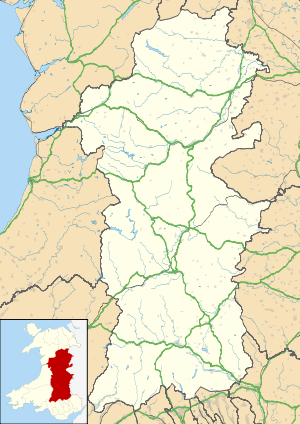Pontneddfechan
Pontneddfechan, spelt Pontneathvaughan (pronounced /pɔntˌniðˈvɔːn/) in English ("bridge over the Little Neath" in Welsh) is the southernmost village in the county of Brecknockshire, Wales, within the Vale of Neath, in the community of Ystradfellte and in the unitary authority of Powys. It stands at the confluence of the Rivers Mellte and Nedd Fechan ("Neath Vaughan") and provides access to the series of waterfalls that adorn the upper Neath valley. Dinas Rock, a pitched anticline in the limestone rocks at Craig-y-Dinas, is coveted by rock-climbers.
| Pontneddfechan | |
|---|---|
 Pontneddfechan Location within Powys | |
| Population | (2001 census) |
| OS grid reference | SN905075 |
| Community |
|
| Principal area | |
| Ceremonial county | |
| Country | Wales |
| Sovereign state | United Kingdom |
| Post town | NEATH |
| Postcode district | SA11 |
| Dialling code | 01639 |
| Police | Dyfed-Powys |
| Fire | Mid and West Wales |
| Ambulance | Welsh |
| UK Parliament | |
| Senedd Cymru – Welsh Parliament |
|
History
Industrial activities in the district started with a 21-year lease of an area of land from the Marquess of Bute by the Quaker entrepreneur William Weston Young, for the sinking of silica mines around Craig-y-Dinas from 1822 onwards. The silica was extracted to make firebricks at the Dinas Firebrick Co. in Pont Walby. In 1843, Young's lease ran out and the then Riddles, Young & Co. firebrick manufacturers moved to new premises on The Green, Neath. The stone sleepers for the silica mine tramway were never removed and can be seen set into the path of the waterfall walk.
In 1857, the Vale of Neath Powder Co. built a "gunpowder manufactory", having obtained "a licence to erect their mills over a space of two miles including the Upper and Lower Cilliepste Falls".[1] The site on the River Mellte was chosen for its remoteness and the availability of both water power and timber for the production of charcoal, one ingredient of gunpowder. An inclined tramway was built from a siding on the Vale of Neath Railway near Pen-cae-drain, to bring in sulphur and saltpetre, the other ingredients. A horse-drawn tramway linked the various buildings. The horses were fitted with copper horseshoes to reduce the likelihood of sparks.[2] In 1862, Curtis & Harvey took over the site. It later merged with Nobel's Explosives Co.[3] and finally became absorbed by Imperial Chemical Industries in 1926.
The works closed in 1931, but the site is still known locally as the Gunpowder Works. It is now administered by the National Park Authority and has a network of footpaths.
The Welsh-language poet Evan Bevan died at Pontneddfechan in 1866.[4]
References
- The Cambrian Newspaper, 10 April 1857.
- The Gunpowder Works.
- Pritchard, Tom, Evans, Jack and Johnson, Sidney (1985). The Old Gunpowder Factory at Glynneath. Merthyr Tydfil: Merthyr Tydfil & District Naturalists' Society [1998 reprint].
- "Evan Bevan". Dictionary of Welsh Biography. National Library of Wales. Retrieved 12 April 2016.
Map sources
- Map sources for Pontneddfechan